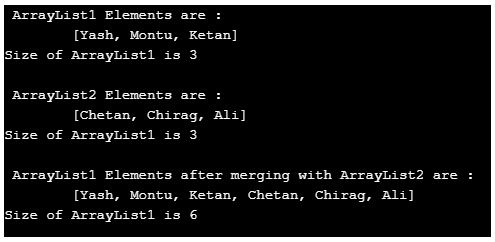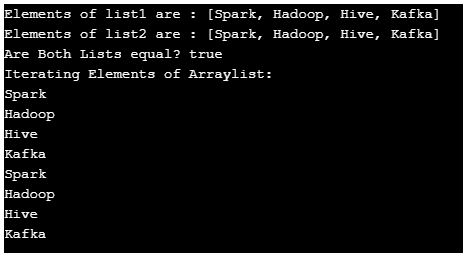Updated March 27, 2023

Introduction to Collection Interface in Java
The Collection Interface is the basic root interface of the Collection Framework and defines the basic methods that all members of the Collection Interface must use; the Collection Framework, which includes various ways of processing, manipulating and accessing data, is based on this Collection Interface.
Collection Interface in Java
Collection interface in java is available in java.util.Collection package and defines the basic methods that all members of the collection family need to implement.
The following methods are defined in the collection interface and should be implemented by all collection frameworks.
| Method Name | Method Description |
| boolean add(Object object) | This method adds the specified object to the collection calling this method. It returns true if the object was added to the collection otherwise returns false if the object is already a part of the collection or if the collection does not allow duplicates elements. |
| boolean addAll(Collection collection) | This method adds all the elements of the specified collection to the collection calling this method. It returns true if the addition is successful, otherwise, it returns false. |
| boolean contains(Object object) | This method returns true if the specified object is a part of the collection calling this method; otherwise, it returns false. |
| void clear( ) | This method removes all elements from the collection calling this method. |
| boolean containsAll(Collection collection) | This method returns true if the collection calling this method contains all specified collection elements; otherwise, it returns false. |
| boolean equals(Object object) | This method returns true if the collection calling this method and the specified object are equal; otherwise, it returns false. |
| int hashCode( ) | This method returns the hash code for the collection calling this method. |
| boolean isEmpty( ) | This method returns true if the collection calling this method contains no elements; otherwise, it returns false. |
| Iterator iterator( ) | This method returns an iterator for the collection calling this method. |
| boolean remove(Object object) | This method removes the specified object from the collection calling this method. Returns true if the specified object was removed, otherwise returns false. |
| boolean removeAll(Collection collection) | This method removes all elements available in a specified collection from the collection calling this method. Returns true if there is a change in collection calling this method; otherwise, it returns false. |
| boolean retainAll(Collection collection) | This method removes all elements from the collection calling this method except those available in the specified collection. This method returns true if there is a change in collection calling this method; otherwise, it returns false. |
| int size( ) | This method returns the number of elements available in the collection calling this method. |
| Object[ ] toArray( ) | This method returns an array that contains all the elements stored in the collection calling this method. The array elements are, in fact, copies of the elements available in the calling collection. |
| Object[ ] toArray(Object array[ ]) | This method returns an array containing only those collection elements of the calling collection whose type matches the type of elements in the specified array. |
Examples of Collection Interface in Java
Given below are the examples of Collection Interface in Java:
Example #1
In this example, we will show methods of collection interface in java. We will see how to use add, addAll and size method.
Code:
package com.edubca.nonprimitivedemo;
// import collections
import java.util.ArrayList;
import java.util.List;
public class DataTypeDemo {
public static void main(String[] args) {
List arraylist1 = new ArrayList();
// Adding elements to arraylist
arraylist1.add("Yash");
arraylist1.add("Montu");
arraylist1.add("Ketan");
System.out.println(" ArrayList1 Elements are :");
System.out.println("\t" + arraylist1);
//printing size of arraylist1
System.out.println("Size of ArrayList1 is " +arraylist1.size() );
List arraylist2 = new ArrayList();
// Adding elements to arraylist
arraylist2.add("Chetan");
arraylist2.add("Chirag");
arraylist2.add("Ali");
System.out.println();
System.out.println(" ArrayList2 Elements are :");
System.out.println("\t" + arraylist2);
//printing size of arraylist2
System.out.println("Size of ArrayList1 is " +arraylist2.size() );
System.out.println();
// Adding elements of both lists to list1
arraylist1.addAll(arraylist2);
// Now Printing modified list
System.out.println(" ArrayList1 Elements after merging with ArrayList2 are : ");
System.out.println("\t" + arraylist1);
//printing size of arraylist1
System.out.println("Size of ArrayList1 is " +arraylist1.size() );
}
}Output:
Example #2
In this example, we will see some more methods of collection interface.
Code:
package com.edubca.nonprimitivedemo;
// import collections
import java.util.ArrayList;
import java.util.List;
// importing iterator
import java.util.Iterator;
public class DataTypeDemo {
public static void main(String[] args) {
// creating array list of type string
ArrayList<String> arraylist1 = new ArrayList<String>();
arraylist1.add("Spark");
arraylist1.add("Hadoop");
arraylist1.add("Hive");
arraylist1.add("Kafka");
System.out.println("Elements of list1 are : " + arraylist1);
ArrayList<String> arraylist2 = new ArrayList<String>();
arraylist2.add("Spark");
arraylist2.add("Hadoop");
arraylist2.add("Hive");
arraylist2.add("Kafka");
boolean isequal=arraylist1.equals(arraylist2); // check if both lists are equal
System.out.println("Elements of list2 are : " + arraylist2);
System.out.println ("Are Both Lists equal? " + isequal);
arraylist1.addAll(arraylist2); // merging both lists
// iterating arraylist
Iterator it=arraylist1.iterator();
System.out.println("Iterating Elements of Arraylist:");
while(it.hasNext()){
System.out.println(it.next());
}
}
}Output:
Conclusion
The above article provides a clear understanding of the collection interface in java and the different methods available in the collection interface. Java code examples covered above shows how members of the collection family use methods of collection interface.
Recommended Articles
This is a guide to Collection Interface in Java. Here we discuss the basic concept, methods, and examples of collection interface in java with code and output. You may also have a look at the following articles to learn more –



